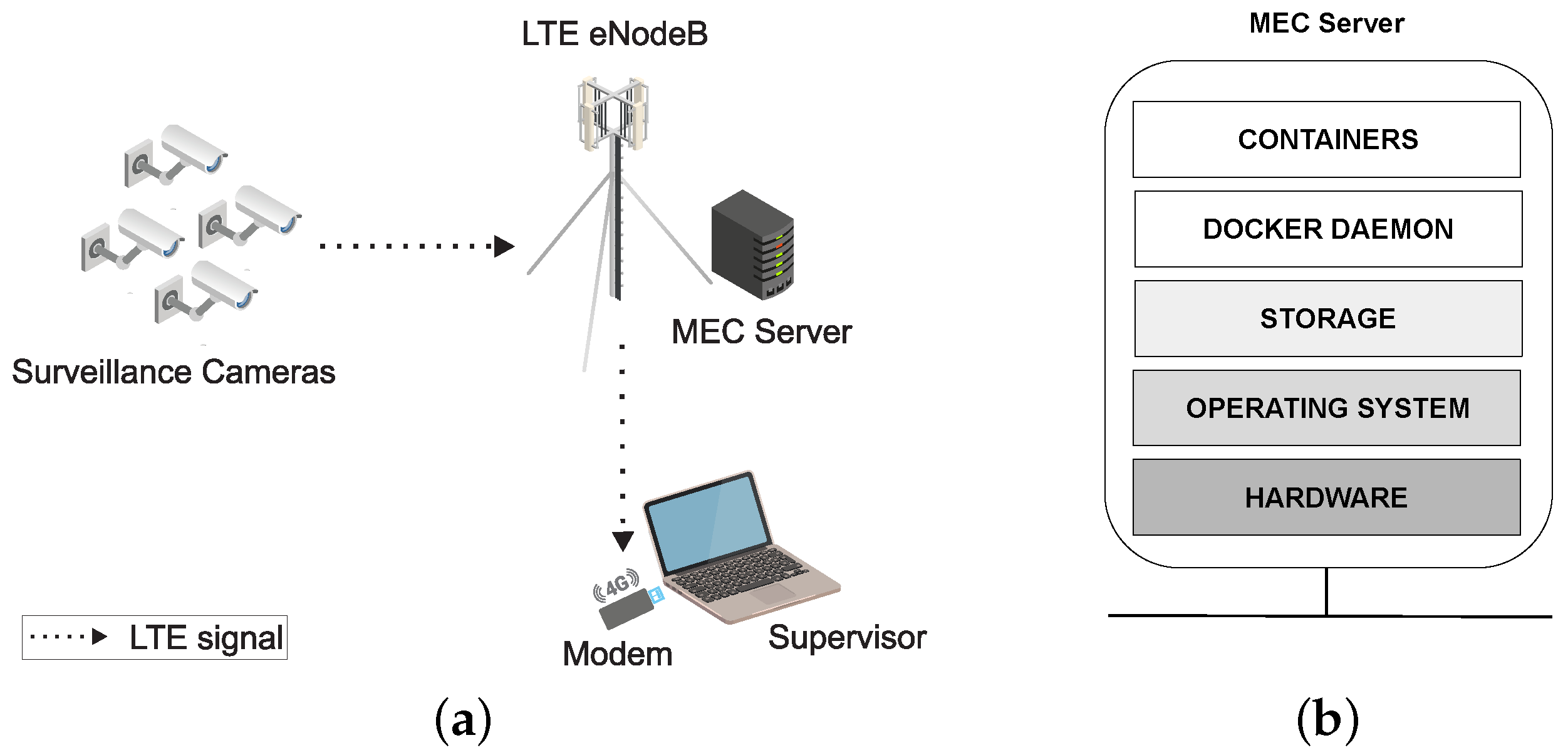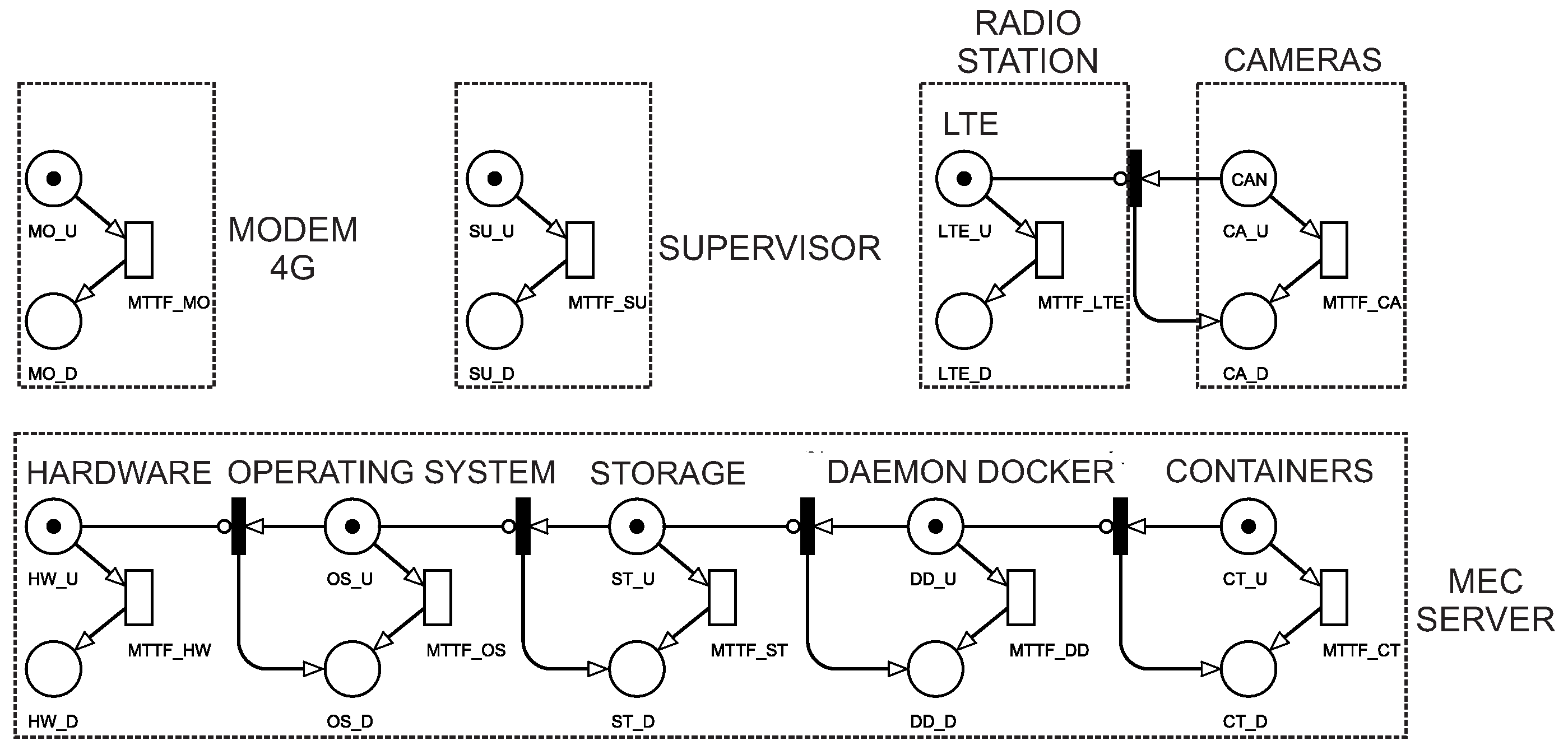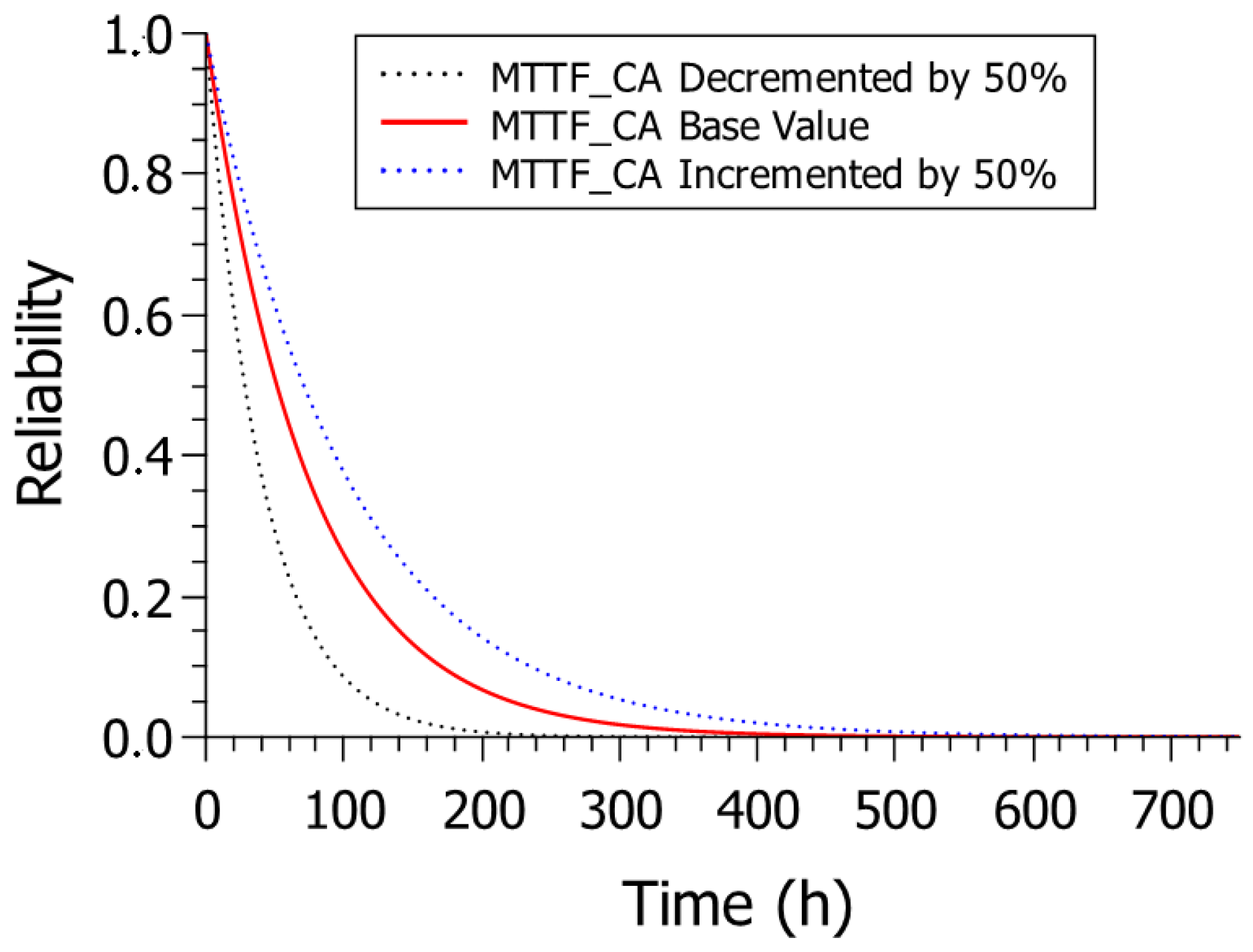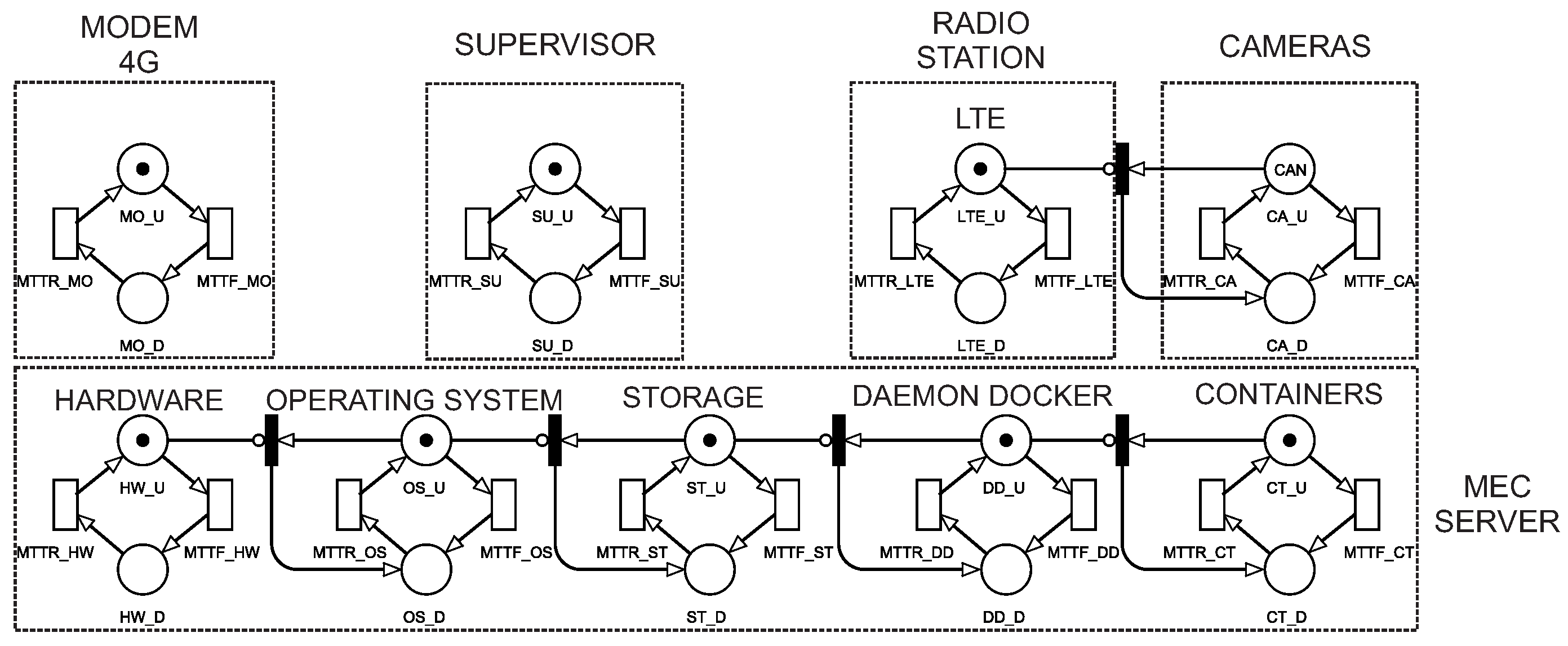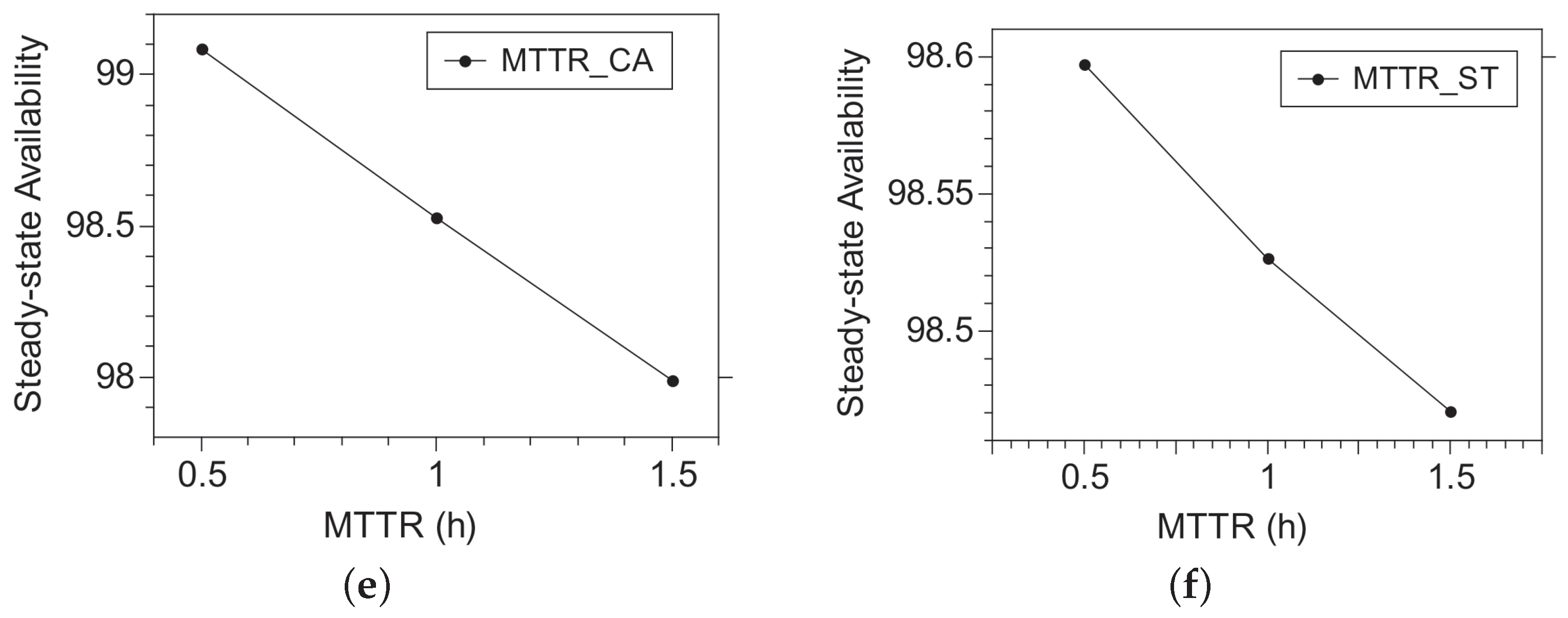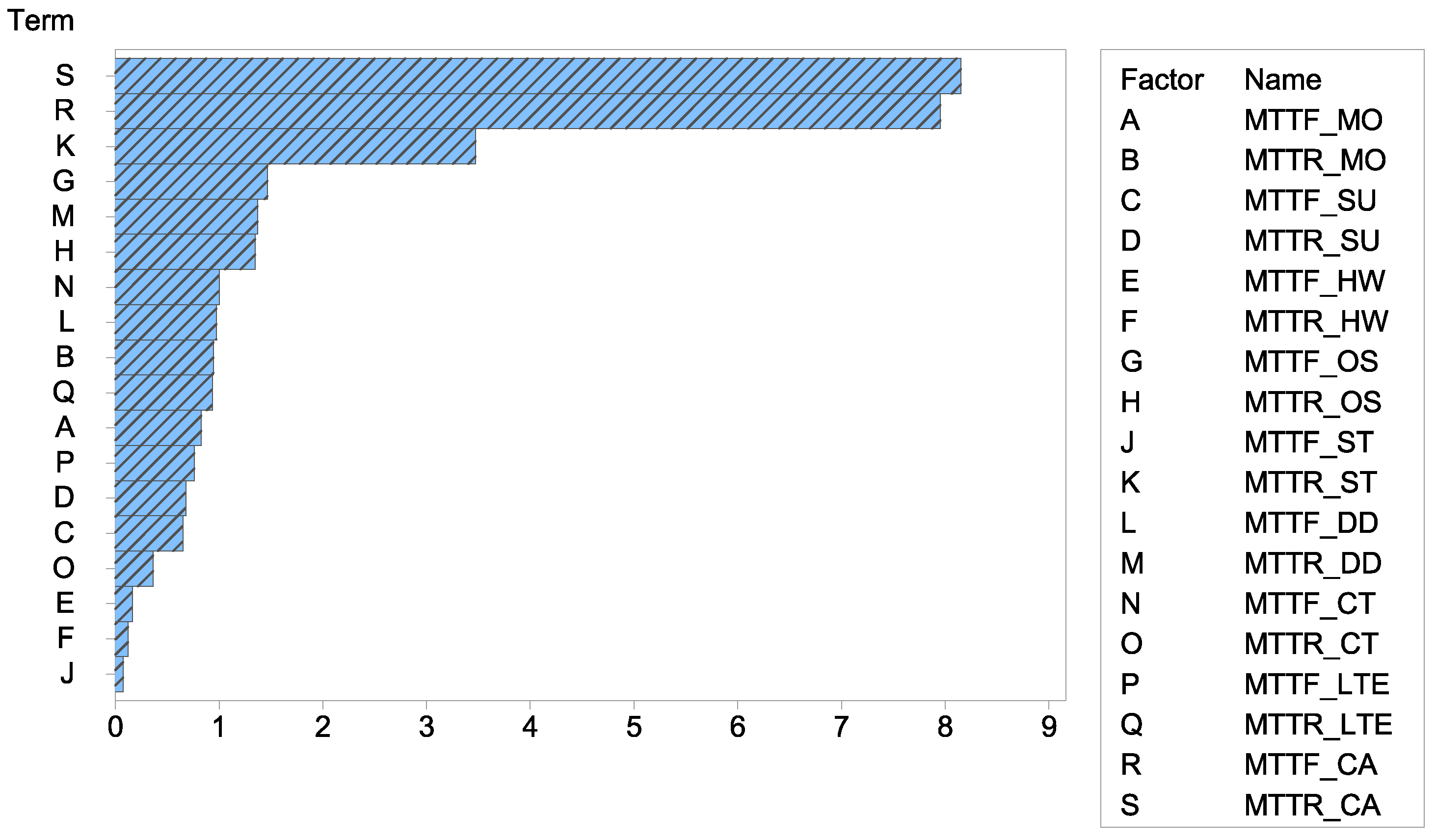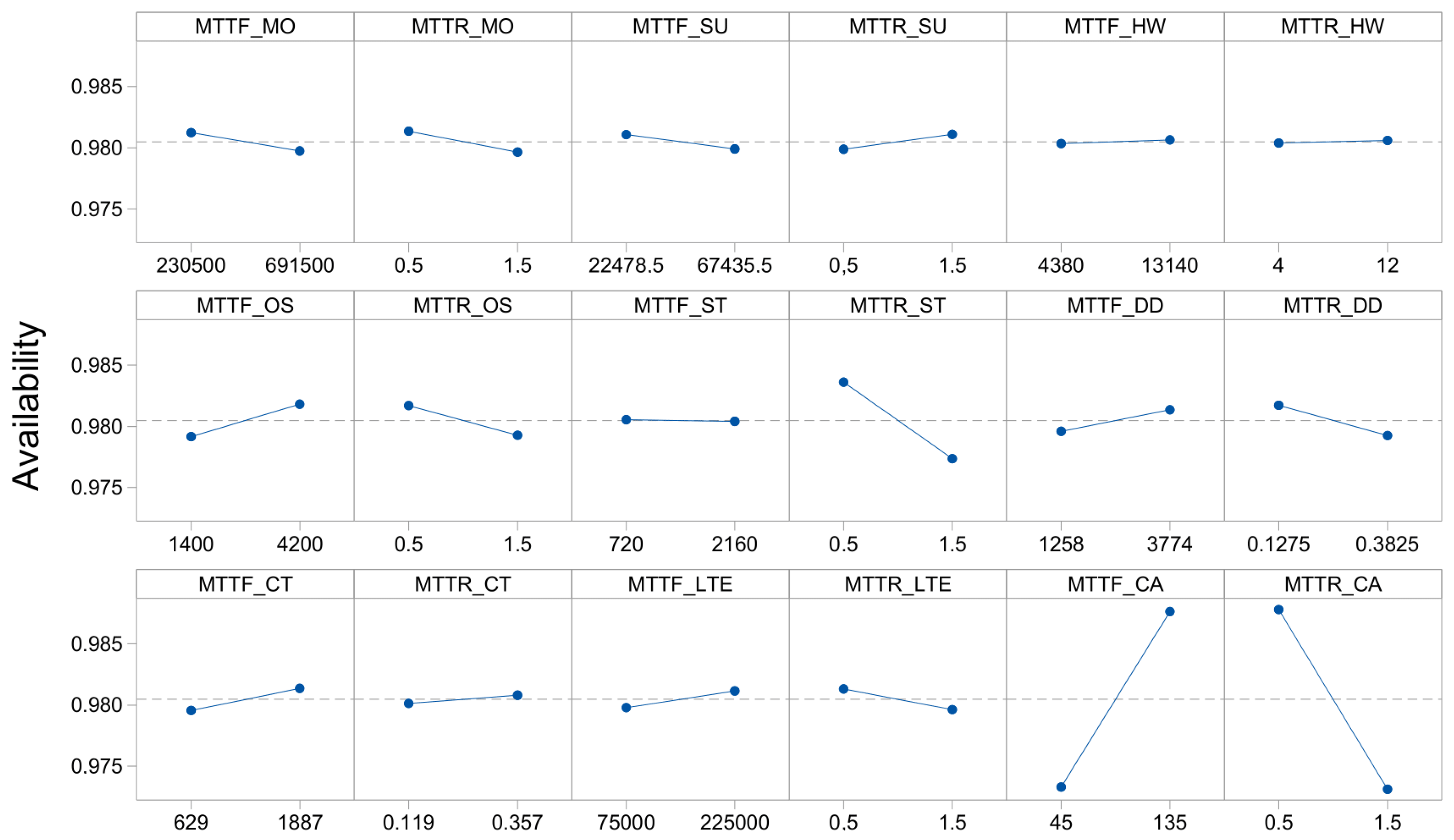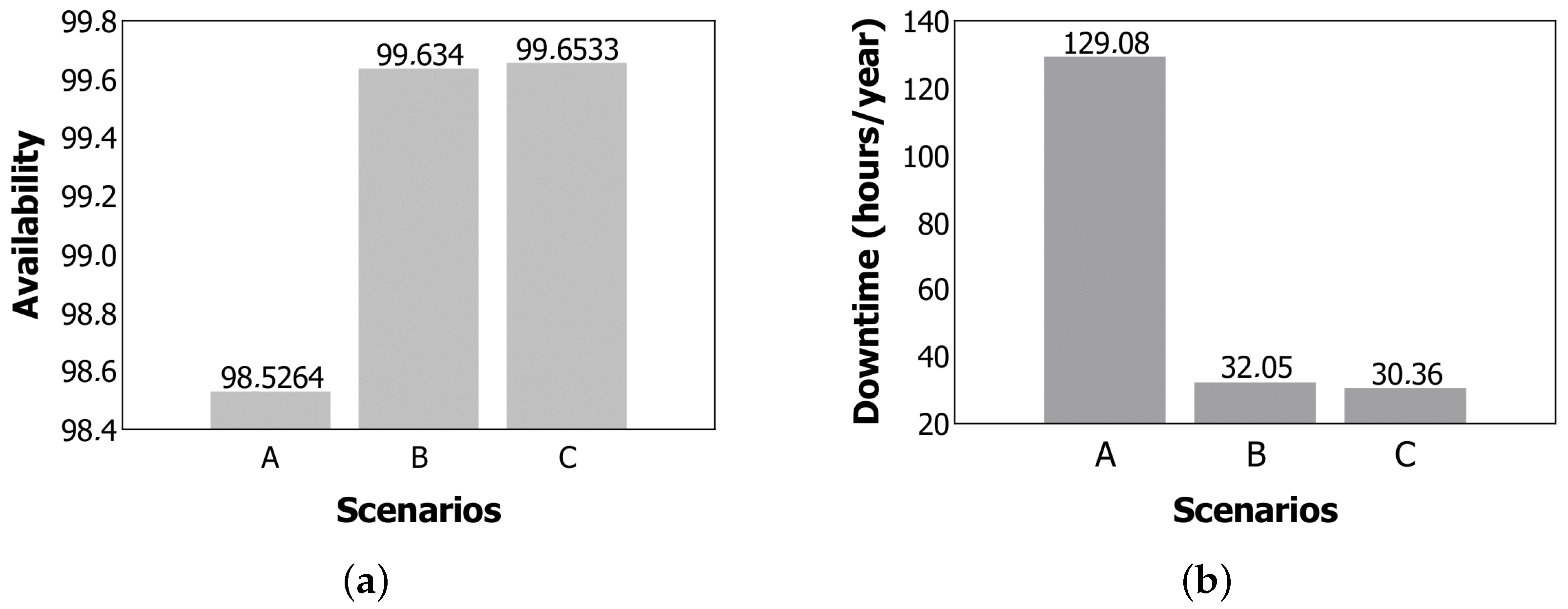1. Introduction
The Internet of Things (IoT) is a communication paradigm that aims to make day-to-day technologies even more immersive and widespread. IoT facilitates access and interaction with several devices, such as surveillance cameras, monitoring sensors, vehicles, and smartphones. IoT seeks to provide new services to citizens, companies, and public administrations by analyzing large masses of data. Cities are becoming increasingly responsive and intelligent [
1]. IoT is present in large cities, making them more automated and technological, the so-called smart cities. The smart city is committed to investing in the quality of life and economic development of people [
2]. Amsterdam is an example of a well-connected smart city reaping the rewards of opening the data vault. The city shares traffic and transportation data with interested parties, such as developers, who then create mapping apps that connect to the city’s transport systems [
3]. In Palo Alto, there are several projects in health, Vehicular ad hoc networks (VANETs) and surveillance monitoring systems.
Smart cities adopt CCTV-based surveillance monitoring systems to provide public services and ensure the safety and security of citizens, e.g., crime prevention and response, forensic evidence. These applications are key drivers when running smart city projects, helping authorities to proactively spot and react to potential incidents across the city. Specifically, surveillance monitoring systems have several important features for a smart city. These features include facial recognition, motion detection, and activities monitoring that minimize the chances of disasters. However, the integration of automated analysis in video surveillance is an area that can be further explored [
4], especially concerning the connectivity of equipment in the security sector. In the security sector, there is still a reliance on the traditional manual monitoring of CCTV (closed circuit television) images [
4].
CCTV consists of cameras distributed and connected to a central system, which makes images available through monitors. The connection of the CCTV components is carried out by cabling. The cable connection may make it impossible to monitor a specific area of smart cities. This way, as solutions to bandwidth and quality of service (QoS) problems, the connection between CCTV components can be wireless, reducing costs and expanding monitoring sectors with high quality. Long-term evolution (LTE) technology is an alternative to providing wireless communication. 5G technology has been gaining ground in telecommunications for the same purpose, but it is still not widespread worldwide. With LTE technology, the CCTV system may have inaccuracies that compromise the service that must be provided in real time. Therefore, evaluating these applications becomes relevant even before a practical implementation in many aspects. In this context, analytical models can be used to evaluate systems during design stages [
5,
6]. Most of the previous work that adopted analytical models have only focused on the assessment of performance metrics [
7,
8,
9,
10,
11,
12,
13,
14]. However, availability and reliability metrics are essential system requirements in this scenario to guarantee a certain level of quality of service (QoS). Wahab et al. in [
15] proposed a three-fold solution to improve the dependability of multi-cloud systems. The authors proposed a trust establishment framework that is resilient to collusion attacks that occur to mislead trust results. A bootstrapping mechanism was also proposed, which capitalizes on the endorsement concept in online social networks to assign initial trust values. The authors also proposed a trust-based hedonic coalition game that enabled services to distributively form trustworthy multi-cloud communities. Experiments conducted on a real-life dataset demonstrated that their model minimizes the number of malicious services compared to three state-of-the-art cloud federations and service communities models. Lockl et al. in [
16] have developed and evaluated a block-chain-based IoT sensor data logging and monitoring system, employing a design science research (DSR) approach. The authors have shown that such systems should provide modality, data parsimony, and availability in addition to domain-specific principles. The proposed prototype improved data integrity and availability but uncovered challenges like high operating costs through smart contract computation fees. Although these are important papers in the fields of cloud computing and IoT, respectively, these studies present a different focus compared to our work (surveillance was not taken into consideration) in terms of architecture and goals. In addition, the authors did not consider reliability as a major metric. Furthermore, designing a surveillance system with uncompromising constraints of high reliability/availability and high processing capacity is challenging in planning for the development of smart cities. Due to the partial failures of several components, the operational services of a surveillance system are probably not offered perfectly even when the system is available in terms of physical resources. In this context, capacity-oriented availability (COA) was used to estimate the information [
17] of system availability based on its capacity of available components.
In this paper, we proposed stochastic Petri net (SPN) models [
18,
19] to represent and evaluate the dependability (availability and reliability) of surveillance monitoring systems in smart cities. SPN models were proposed by researchers active in the applied stochastic modeling field, with the goal of developing a tool which allowed the integration of formal description, proof of correctness, and performance evaluation. For what concerns the last aspect, the proposals aimed at an equivalence between SPN and continuous time Markov chain (CTMC) models. This way, SPN is superior compared to CTMC in terms of intuitive representation capabilities. SPN can be used to model any complex systems because it can model, for example, process synchronization and parallelism. The SPN models are based on a CCTV architecture, using LTE connection, and a server at the edge of the network (mobile edge computing—MEC).
Therefore, the main contributions of this paper are:
An SPN model to assess the availability of a CCTV monitoring system in smart cities. The proposed model enables the configuration of a significant number of parameters, including 16 transitions corresponding to mean times to failure (MTTFs) and repair (MTTRs).In addition, the model is highly scalable in terms of the number of cameras and radio stations.
An SPN model to assess the reliability of a CCTV system. The reliability model, in turn, presents nine configurable transitions, with the aforementioned advantages of the availability model, but also the capability of calculating the reliability in different scenarios over time.
A set of sensitivity analyses on the model’s components to identify those that most impact the metrics of interest. Sensitivity analysis showed that specific components have a more significant impact on availability. To reinforce the sensitivity analysis results, we used the design of experiment (DoE) method. The DoE made it possible to visualize more precisely the impact of the MTTF and MTTR values of each component on the availability of the system.
Case studies that serve as guides for how evaluators can use the proposed models, adopting the COA metric, for example. Capacity-oriented availability (COA) assesses how the system is delivered, therefore, it does not consider only the states of availability or unavailability, but the real impact of these factors in service delivery.
The rest of the paper is organized as follows. We mention some related works in
Section 2. The overall architecture of a surveillance monitoring system in smart cities is detailed in
Section 3. Reliability modeling and assessment is presented in
Section 4. In
Section 5, we develop availability models and perform various availability analyses. Case-studies of the surveillance monitoring system are presented for availability assessment in
Section 6. The paper is concluded in
Section 7.
2. Related Work
This section presents some related works. These works include an evaluation of a system that uses the idea of a base station with 4G or 5G and developed analytical models for such evaluation.
Table 1 summarizes a comparison of related works under four aspects: model type; metrics; communication type; and sensitivity analysis.
The first criterion refers to the
type of model. All previous works in consideration used Markov chains as a common analytical modeling approach to evaluate their proposals. In [
20], the Markov chain was used in modeling to meet the best up-link while in [
10], a Markov chain model was used in a proposal to perform evaluations on different performance metrics, in which the sizing of the system elements can be analyzed. The papers [
7,
8] used the Markov chain to evaluate the femtocells connections aiming to reduce latency and improve performance in wireless networks. However, no papers have used Petri nets. Instead of SPN, the use of Markov chains is not a limitation, since both models are equivalent, but SPN has a higher power of abstraction.
Concerning the
metrics, the majority of works opted for performance evaluation. Some papers [
12,
14,
20] presented innovative proposals for 5G. In [
13], for example, the 5G network was studied in a compensation strategy between energy consumption and the additional delay incurred for user traffic. Markkula and Haapola in [
11] addressed a performance evaluation using 4G. Only the work [
20] used the reliability metric to investigate the problem of cooperative re-transmission and the ideal number of devices directly connected to the LTE base station. However, none of the studies explored the metrics of availability and downtime.
Type of communication corresponds to the use of which generation of communication technology was adopted. More recent articles show studies focused on 5G. The less recent articles show studies focused on 4G. In [
12], 5G communication was used for the study of cell failure detection in base stations, in which users could obtain mobile services that met their requirements. Cartney et al. [
14] used 5G communication to describe a base station placement optimization, providing a detailed analysis of the performance. Markkulai et al. [
11] used 4G communication to overcome problems related to the lack of connectivity of the base station. Our work used 4G technology since 5G technology has paradigms that are still being studied to be implemented in the future in many countries. However, it is important to highlight that our models are configurable enabling the use 5G parameters without issues. Finally, regarding
sensitivity analysis, none of the related works explored such a strategy.
4. Reliability Assessment
This section presents an SPN model to assess the reliability of the surveillance system in smart cities.
Petri nets are a formal model of quantitative properties of concurrent and synchronized systems. Petri nets with random firing delays are considered as stochastic Petri nets (SPNs) [
22,
23,
24,
25,
26]. Since the last decade, SPN has been enticing the researchers’ attention in the modeling and performance analysis of discrete event systems. SPNs are modeling tools for the performance analysis of parallel, concurrent, dynamic and distributed systems. The nature of temporal specification can be deterministic or probabilistic. Variable
X as a stochastic process can be considered as a family of functions of time as sample paths of the events of process, formally defined as
, where
. Each sample path denotes a particular trajectory over the state space and consists of a possible observed behavior of the process events.
4.1. Reliability SPN Model
Figure 2 presents an SPN model that was used to assess the reliability of a surveillance system in smart cities. The SPN model was composed of supervisor (
SU), 4G modem (
MO), wireless based station (
LTE), cameras (
CA), and an MEC server. The MEC server has components with dependence; when a component fails, the immediate transitions will make the next components that depend on it fail as well. The MEC server is composed of: hardware (
HW); operating system (
OS); storage (
ST); docker daemon (
DD); and containers (
CT). Each component has a
MTTF. As reliability only considers system services until a failure occurs, it is not necessary to use
MTTR. We will only estimate the time for which the system is up and running.
The 4G modem will be working when it has a token in place MO_U. The 4G modem is not working when it has a token in place MO_D. The modem goes into the inactive state by triggering the transition MTTF_MO. The supervisor is working when it has a token in place SU_U. The supervisor is not working when it has a token in place SU_D. The modem goes into the inactive state by triggering the transition MTTF_SU.
The MEC is composed of several components that depend on each other. When the hardware (HW) fails, all other components will also fail. The MEC is working when it has a token in CT_U (active container). If the container is working, all other components that make up the MEC will be working. We consider that the MEC is not working when it has a token in CT_D (inactive container).
For example, we consider that a wireless base station will be functioning when it has 10 tokens in the location
CA_U (active cameras). We consider that a wireless base station is not working when it has one or more tokens at
CA_D (cameras disabled). The equation for calculating the reliability of the system is given by
where
P stands for probability and # stands for the number of tokens in a given location.
In DoE, the camera was the most critical component of the system. Therefore, the reliability assessment was performed by exploring the MTTF of the cameras.Three scenarios were explored using the base value for the cameras MTTF and two more variations—50% more and 50% less than the base value.
4.2. Reliability Evaluation Results
Some input parameters are needed to evaluate the proposed model. The values are the same as those used for the availability assessment listed in Table 7. However, a variation of the cameras
MTTF is used to explore different scenarios.
Table 2 shows the input parameters.
Figure 3 presents the result of the reliability analysis for the different scenarios explored. Initially, for a low service time, the reliability of the system is 100%. However, as time increases, the reliability decreases. With the value of
MTTF_CA using less 50% of the base value, the model obtained the lowest reliability, which presents approximately 0% reliability after 250 h of service. With the base value of
MTTF_CA, the model showed more excellent reliability than the scenario with
MTTF_CA using less than 50% of the base value, presenting approximately 0% reliability just after 390 h of operation. The most satisfactory result was obtained by
MTTF_CA using an additional 50% of the base value, where the model showed approximately 0% reliability only after 540 h of service.
5. Availability Assessment
This section presents an SPN model to assess the availability of a surveillance system in smart cities. The model was developed when considering the recovery of system components in the reliability model in
Figure 2 as a solution to improve the quality of service for the surveillance monitoring system.
5.1. Availability SPN Model
Figure 4 presents a model consisting of a supervisor (
S), 4G modem (
MO), a wireless base station (
LTE), cameras (
CA), and an MEC server. The MEC server is composed of several components that depend on each other. When a component fails, the immediate transitions will cause the next components that directly or indirectly depend on it to fail as well. The components that make up the MEC are the hardware (
HW); operating system (
OS); storage (
ST); docker daemon (
DD); and containers (
CT). The wireless base station, with its proper cameras, also established a dependency. If the wireless base station fails, the cameras will also stop working.
Each component has an MTTF (mean time to failure) and a MTTR (mean time to repair). The 4G modem will be working when it has a token in place MO_U (4G modem up). We considered that the 4G modem was not working, when it had a token in place MO_D (4G modem down). The active/inactive changes were caused by the transitions triggering: MTTF_MO and MTTR_MO. The supervisor was working when it had a token in place SU_U (supervisor up). We considered that the supervisor was not working when it had a token in SU_D (supervisor down). The active/inactive changes were caused by the triggering of the transitions MTTF_SU and MTTR_SU.
The MEC server will be working when it has a token in CT_U (container up). We considered that the MEC was not working when it had a token in one of the following places: HW_D (hardware down); OS_D (operating system down); ST_D (storage down); DD_D (docker daemon down); CT_D (container down). Only one component of the MEC server needs to fail for it to stop working; this is due to the dependency already mentioned. The change between the active and inactive state is caused by the transitions: MTTF_HW, MTTF_OS, MTTF_ST, MTTF_DD and MTTF_CT—for mean time to failure—and MTTR_HW, MTTR_OS, MTTR_ST, MTTR_DD and MTTR_CT—for mean time to repair.
We considered that a wireless base station was working when it had a token in place CA_U (cameras up). We considered that a wireless base station was not working when it had a token in the locations: LTE_D (wireless base station down) and CA_D (cameras down). The change between the active and inactive state was caused by the transitions: MTTF_LTE, MTTF_CA—for mean time to failure—and MTTR_LTE, MTTR_CA—for mean time to repair.
Table 3 shows the guard conditions used for the system’s operation. Guard conditions are used in transitions to ensure that they are only triggered with a specific condition, preserving behaviors that occur in real life. For example, the transition
MTTR_OS has the following guard condition:
, meaning that to trigger the recovery transition of the operating system, the hardware must be active. In other words, the solution to a failure in an operating system can only occur if the hardware is turned on. However, the guard condition ensures that the model retains behaviors that occur in real contexts.
The availability metric was explored for this model. The availability equation represents all the probabilities of the number of tokens in the system’s constituent components’ upstate. Thus, P stands for probability, and # stands for the number of tokens in a given location. Some components depend on others being active, so we only used the last components of the dependency sequences in the availability metric. For the availability metric, we only used the container (
CT) of the MEC Server because for the container to be working, all the MEC server components must be active. For a radio station to be working, all that is required is for its own cameras (
CA) to be active. Equation (
2) represents the condition described above:
5.2. Sensitivity Analysis
This section presents two sensitivity analyses on the model’s factors. The objective was to identify the factors that most impact the availability of the system. First, an analysis based on the percentage difference technique was performed [
27,
28]. Then, we present a second complementary analysis based on the DoE technique [
29].
5.2.1. Sensitivity Analysis of Transitions with Percent Difference
For the sensitivity analysis, the model’s
MTTF and
MTTR times were used as parameters varying them 50% more and less over the base value. Thus,
Table 4 presents, in decreasing order, the transitions with the highest sensitivity indices—that is, those that have the most significant impact on the availability of the system.
To better illustrate the influence of the parameters,
Figure 5 represents the variation in the availability of the main parameters.
Figure 5a–d show the
MTTF parameters where availability tends to increase with the increase in
MTTF.
Figure 5e,f show that increasing MTTR reduces availability. The variation in the model parameters provides an overview of the system’s behavior.
5.2.2. Sensitivity Analysis
This section presents the sensitivity analysis with DoE [
29]. The established factors were the
MTTF and the
MTTR of each constituent component of the system. We used two levels for the factors of the experiment. The first level refers to a decrement of 50% under the base value shown in Table 7. The second level refers to an increment of 50% under the base value.
Table 5 presented the factors and levels used to perform the DoE based on the availability metric.
Figure 6 shows the Pareto graph for factors related to the availability metric. The effects of the
MTTR_CA factor and the
MTTF_CA factor have more significant influence under availability. Therefore, changing the mean repair time’s values and the mean failure time of the cameras is decisive in the efficiency of the surveillance system.
Figure 7 shows the main effects graph for the availability metric. The graph represents the availability to perform the tests at each level for each of the defined factors. In this graph, the more vertical the line, the more significant influence that factor has on system availability. As shown in the Pareto graph, in this main effect graph, the
MTTF_CA factor and the
MTTR_CA factor are the factors that have the most significant effect on availability.
MTTF_CA, in its first level, has an availability of 97.3%, and in its second level, it has an availability of 98.7%; therefore, it was a significant increase in availability. In its first level of
MTTR_CA, it has an availability of 98.7%, and in its second level, it has an availability of 97.3%; therefore, it was a significant reduction in availability.
MTTR _ST, in its first level, has an availability of 98.3%, and in its second level, it has an availability of 97.7%; therefore, it was also a significant reduction in availability. The remaining factors are not relevant to availability.
As shown in the previous graph, the three factors that most influence system availability were highlighted, the
MTTR_ST, the
MTTR_CA, and the
MTTF_CA.
Figure 8 shows the interaction graph for these three factors. With this graph, it is possible to analyze which levels have more significant interference in the experiments’ final result. In other words, we can say that the higher the intersection of the lines, the greater the interaction between the factors. In the first interaction,
MTTR_ST has a significant impact on availability when there are changes in its levels, at the moment when
MTTR_CA is at its second level. In the second interaction,
MTTR_ST has a relevant impact on availability when there are changes in its levels, at the moment when
MTTF_CA is at its first level. Finally, in the last interaction, the change in
MTTR_CA levels has no significant impact on availability at the time that
MTTF_CA assumes its two levels.
7. Conclusions
In this paper, we proposed SPN models for dependability modeling and the evaluation of a typical surveillance monitoring system in smart cities. Reliability and availability attributes, as essential dependability representatives for high quality of service, were investigated in a comprehensive manner. The reliability assessment was performed by varying surveillance cameras’ MTTF, showed an increase in reliability when increasing their respective MTTF. Furthermore, various scenarios for availability evaluation were investigated, making it possible to observe each component’s impact. The best results were indicated in the scenarios with a high level of redundancy for wireless base stations. Sensitivity analysis was applied to identify the components that have the most significant impact on availability. In this way, the impact of different MTTF and MTTR values for each component was measured. Sensitivity analysis showed that specific components have a more significant impact on availability. To reinforce the sensitivity analysis results, we used the DoE method to precisely visualize the impact of the MTTF and MTTR values of each component on the availability of the system. On the other hand, system availability can be enhanced in different ways, such as selecting components with a better MTTF. Furthermore, this study also pointed out that the camera is apparently the most critical component of the system that sensitively causes either a positive or negative impact on reliability/availability for the high quality of the service of the surveillance system. Last but not least, the combination of performance and availability models can be a proper future extension to investigate performability issues in surveillance monitoring systems.
